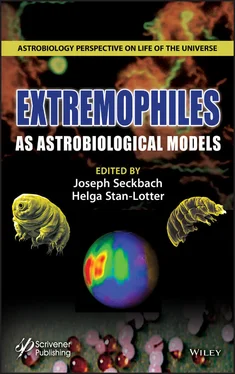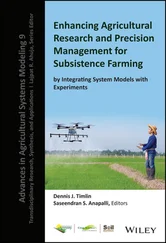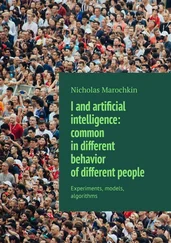Recent findings suggest that microbiomes which are found in brackish, marine and hypersaline modern sapropels (‘rotten mud’) include yet uncultured Archaea that may be close to the evolutionary roots of eukaryotes and life itself (Andrei et al. ). The extreme geochemistry of certain sapropels, as well as their relevance in the preservation of biomarkers, might qualify them as analogs for early Earth habitats or for the exploration of habitable extraterrestrial milieus.
Expansive evaporite mineral deposits on Mars are evidence of ancient lacustrine systems (Bayles et al. ). As the surface water dried up, hypersaline lakes would have filled the ancient lake basins. Halite and gypsum contain fluid inclusions where microorganisms may be entombed over geologic time. Haloarchaea are also resistant to other extremes, such as high radiation doses. These properties make them excellent analogues for life that could have existed in the hypersaline lakes on Mars and perhaps remained preserved in the evaporitic minerals there.
Historical observations of NASA’s activities towards Mars (Viking experiments) are presented by Oremland, including the early enthusiasm for astrobiology (although that name was not yet coined in the 1970s). His research focuses on soda lakes, which are alkaline (pH ≥ 9.5), often hypersaline (salinity > 35 g/L), mineral-rich water bodies, and their amazingly intense microbial populations, such as haloalkaliphilic arsenotrophs, which are capable of using As(V), Fe(III), or S(0) as electron acceptors. The possibility of similar environments on Mars or planetoids (Enceladus, Titan) is considered.
Antarctica is a rich source of extremophiles, not just psychrophiles, but polyextremophiles which are exposed to unusually high level of UV radiation for Earth, hyperarid conditions, hypersaline conditions, and extremely low nutrients (Abbott and Pearce). Notable similarities exist to conditions known to occur on Mars, or to what is known of the icy moons of Jupiter and Saturn.
Today, Earth harbors vast oceanic ecosystems—most of them only barely explored— which support life (psychrophilic, barophilic and chemosynthetic) adapted to conditions that may occur in other planets in the universe (George). Climate change-induced processes may slow down major ocean currents, such as the Antarctic Bottom Water (ABW) flowing into the lower hadal or ultra-abyssal zone at a depth greater than 8,000 meters, with potential creation of hypoxic hadal zones at extreme ocean depths and its consequences.
In Part II, experiments with extremophiles in space, e.g., on the International Space Station, are presented. Bacteria as well as Archaea, lichens, fungi, algae and tiny animals (tardigrades) are now being investigated for their tolerance to extreme conditions in simulated or real space environments. Experimental results from exposure studies on the International Space Station and on space probes for up to 1.5 years are presented.
Anhydrobiotic cyanobacteria of the genus Chroococcidiopsis possess a remarkable resistance to desiccation and radiation. These cyanobacteria were exposed to laboratory simulations that mimic planetary conditions, such as dryness, UV and gamma radiation, and also to real space conditions on the International Space Station (Billi). The resistances found are discussed with respect to lithopanspermia.
Lichen species, which are composite organisms consisting of algae or cyanobacteria in a mutualistic relationship with filaments of various fungi, are well-known survivors of the most stressful environments. The first space experiments were carried out with Rhizocarpon geographicum and Xanthoria elegans in the Foton-M2 satellite in 2005 (de la Torre Noetzel and Sancho). Space simulation and space exposure experiments have focused on these and other lichen species, demonstrating their high capacities of survival and recovery.
The halophilic archaeon Halococcus morrhuae and the biofilm-forming bacterium Halomonas muralis were exposed to space conditions during the EXPOSE-R2 mission. Hlm. muralis was much less resistant to extreme conditions than Hcc. morrhuae (Leuko et al. ). Exposure to outer space had a strong detrimental effect on the survival and genomic stability of Hcc. morrhuae ; however, Hcc. morrhuae could be re-cultivated from samples exposed on the ISS for up to 534 days. These results add to our understanding that life may be able to survive the travel through space.
The cryptoendolithic endemic black fungus Cryomyces antarcticus was isolated from sandstone collected in the McMurdo Dry Valleys in Antarctica, a place which is considered the coldest hyperarid desert on Earth and one of the best terrestrial analogues for Mars (Onofri et al. ). C. antarcticus is able to survive intense ionizing radiation, probably due to the presence of a highly melanized thick cell wall.
In Part III, several authors provide reviews on specific topics, such as Jönsson on the properties of tardigrades (also called water bears), which were used in the Foton-M3 mission and survived a combined exposure to space vacuum, cosmic radiation and UV radiation. The evidence for their metabolic arrest (cryptobiosis) and multiple resistances to environmental extremes make these tiny animals (size ca. 1 mm or less) particularly useful astrobiological models.
Nicholson reviews bacterial endospores, the very first model of cells used for astro-biological purposes, and demonstrates their connection to and impact on the history of origin-of-life studies as well as the concept of lithopanspermia. Modern experimental testing of this concept involves using ballistic devices to simulate the interplanetary exchange of rocks containing bacterial spores.
Paul and Mormile consider the very basic problem of available sources of energy for microbial life on Mars. They analyzed the utilization of several available compounds— hydrogen and methane as key molecules, but also iron, sulfur and others—by extremophilic microorganisms, providing numerous examples of a wide range of well-described biochemical reactions. A cautious look at the possible connection to the energy demands of potential human settlements is also included.
Part IVcontains articles on theory and hypotheses. The search for extraterrestrial life is closely connected with the question of the origin of life on Earth and its early evolution. Newer proposals emphasize the importance of environmental oscillations and suggest experiments for testing this on a laboratory scale (Kompanichenko and Levchenko).
Several theories exist on the existence of a prebiotic world, which are outlined by Jheeta. The implications of the vast—and probably still underestimated—horizontal gene transfer and the potential role of viruses and RNA are presented. One or several transitional (T)-LUCAs (last universal common ancestor) are postulated as leading to the emergence of the first cells.
Recent evidence for an unprecedented archaeal diversity (uncultivated strains) and novel bacterial phyla, due to significantly improved sampling of the subsurface and whole genome sampling, has greatly extended our views on the LUCA of all life, including viruses and their consideration as ancient forms of life (Lineweaver).
Instrumentation for the search of sulfur isotopes as biomarkers for potential habitats for extremophiles in the Solar System is proposed by Chela-Flores, together with a discussion of the pros and cons for possible life on the celestial bodies close to Earth (Moon, Mars, Europa, Titan, and the icy moons).
The search for extraterrestrial life has been declared as a goal for the 21st century by NASA, ESA and other space agencies. For meaningful missions, careful planning of sites to be selected and knowledge of their properties is essential. The study of extremophiles on Earth has already provided rich information about the physico-chemical limits of life; these studies need to be extended with a focus on the specific technical requirements of future space missions. For Mars, a recent report suggested four potential sites for extremophiles—caves, deep subsurface, ices, and salts—and outlined measurement techniques and detection methods [2].
Читать дальше












